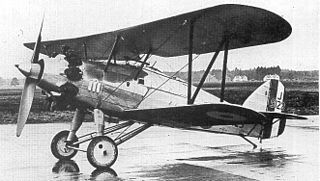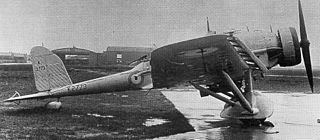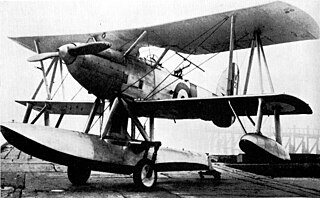
The Aero A.23 was a Czechoslovakian airliner of the 1920s. Aero Vodochody had produced the first Czech airliner, the A.10, four of which had served with ČSA, the national airline. The A.23, another biplane, was bigger, more powerful, and could carry more passengers.

The Blackburn T.R.1 Sprat was a British single-engine two-seat biplane trainer, built in 1926 for advanced training, deck-landing and seaplane experience. Just one was built.

The Blackburn 2F.1 Nautilus was a British single-engine two-seat biplane spotter/fighter built in 1929. Only one was completed.

The Gloster Goral was a single-engined two-seat biplane built to an Air Ministry contract for a general-purpose military aircraft in the late 1920s. It did not win the contest and only one was built.

The Gloster Goring was a single-engined two-seat biplane designed to meet 1926 Air Ministry specifications for a day/torpedo bomber. It was not put into production and the one aircraft built served later as an engine testbed.

The Gloster TC.33 was a large four-engined biplane designed for troop carrying and medical evacuation in the early 1930s. Only one was built.

The Fairey Fleetwing was a British two-seat, single-engine biplane designed to an Air Ministry contract for carrier-based reconnaissance operations in the late 1920s. Only one was built.

The Vickers Type 161 was an unusual 1930s pusher biplane interceptor, designed to attack aircraft from below with a single upward-angle large calibre gun. The aircraft flew well but the concept was abandoned and only one was built.

The Vickers Type 207 was a single-engined two-seat biplane designed as a shipborne torpedo bomber to an early 1930s specification. Structurally innovative, only one was built.

The Vickers Type 253 was a single-engined two-seat biplane general-purpose military machine built to a 1930 government specification. It won a production contract, but this was transferred to the same company's monoplane equivalent, the Wellesley. Only one Type 253 was built.

The de Havilland DH.27 Derby was a large single-engined biplane designed to a heavy day bomber Air Ministry specification. It did not reach production.
The de Havilland DH.72 was a large British three-engined biplane bomber, designed as a Vickers Virginia replacement. It did not go into production.
The Fairey S.9/30 was a two-seat, single-engined biplane built to meet an Air Ministry specification for a fleet reconnaissance aircraft. It flew during 1934–36 in both land- and seaplane configurations. Although only one was built, it was the progenitor of the Fairey Swordfish.

The Hawker F.20/27 was a British fighter design built to an Air Ministry specification for an interceptor in the late 1920s. It was a single-seat biplane powered by a radial engine; the very similar but V-12-engined Hawker Fury development proved superior and only one F.20/27 was built.

The Handley Page H.P.47 was a British single-engined low-wing monoplane built to an Air Ministry specification for a general-purpose bomber and torpedo bomber aircraft. Only one was built.
The Parnall Pike was a 2/3-seat biplane reconnaissance aircraft, capable of operating off carrier decks or from water, built to an Air Ministry specification in 1927. Only one was constructed.

The Parnall Pipit was a single-engined, single-seat naval fighter designed to an Air Ministry specification in 1927. Two prototypes were built but both were destroyed by tail flutter.
The Short S.6 Sturgeon was a prototype single-engined biplane naval reconnaissance aircraft, built to an Air Ministry specification but mostly intended as a demonstrator of the corrosion resistance of duralumin aircraft structures. Two were made.

The Short Gurnard was a single-engined two-seat biplane naval fighter, built in the United Kingdom to an Air Ministry specification in 1929. It failed to win production orders and only two flew.
The Westland PV.7 was a private venture submission to a 1930s British specification for a general-purpose military aircraft with two crew. It was a single-engined, high-wing monoplane of promise, but was destroyed early in official tests.















